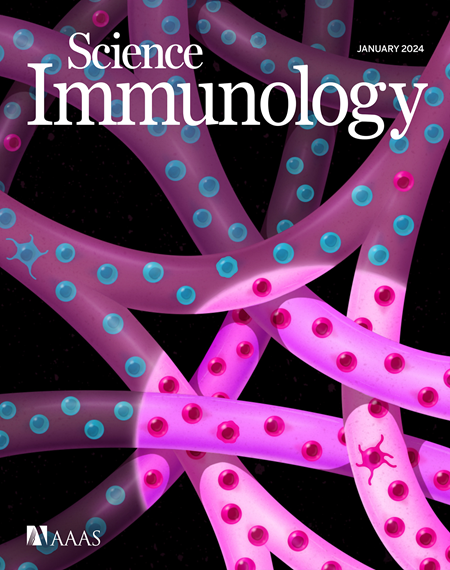具有促进 B 细胞功能的与年龄相关的 CD4+ T 细胞在自身免疫中受 ZEB2 的调控。
IF 17.6
1区 医学
Q1 IMMUNOLOGY
引用次数: 0
摘要
衰老是自身免疫的一个重要风险因素,许多自身免疫疾病往往在成年期发病。我们通过流式细胞术和大量 RNA 测序对 354 名自身免疫疾病患者和健康对照者的 CD4+ T 细胞亚群进行了广泛分析。结果,我们发现了一种独特的 CXCR3midCD4+ 效应记忆 T 细胞亚群,它随着年龄的增长而扩大,我们将其命名为 "年龄相关辅助 T(ThA)细胞"。ThA 细胞具有细胞毒性表型和 B 细胞辅助功能,这些特征受转录因子 ZEB2 的调控。与 ThA 细胞高度倾斜的 T 细胞受体使用情况相一致,系统性红斑狼疮患者 ThA 细胞的基因表达反映了疾病的活动性,并受到钙神经蛋白抑制剂治疗的影响。此外,对单细胞 RNA 测序数据的分析表明,ThA 细胞浸润了自身免疫性疾病患者的受损器官。总之,我们对ThA细胞的描述可能有助于人们更好地理解衰老与自身免疫性疾病之间的关系。本文章由计算机程序翻译,如有差异,请以英文原文为准。
Age-associated CD4+ T cells with B cell–promoting functions are regulated by ZEB2 in autoimmunity
Aging is a significant risk factor for autoimmunity, and many autoimmune diseases tend to onset during adulthood. We conducted an extensive analysis of CD4+ T cell subsets from 354 patients with autoimmune disease and healthy controls via flow cytometry and bulk RNA sequencing. As a result, we identified a distinct CXCR3midCD4+ effector memory T cell subset that expands with age, which we designated “age-associated T helper (THA) cells.” THA cells exhibited both a cytotoxic phenotype and B cell helper functions, and these features were regulated by the transcription factor ZEB2. Consistent with the highly skewed T cell receptor usage of THA cells, gene expression in THA cells from patients with systemic lupus erythematosus reflected disease activity and was affected by treatment with a calcineurin inhibitor. Moreover, analysis of single-cell RNA sequencing data revealed that THA cells infiltrate damaged organs in patients with autoimmune diseases. Together, our characterization of THA cells may facilitate improved understanding of the relationship between aging and autoimmune diseases.
求助全文
通过发布文献求助,成功后即可免费获取论文全文。
去求助
来源期刊

Science Immunology
Immunology and Microbiology-Immunology
CiteScore
32.90
自引率
2.00%
发文量
183
期刊介绍:
Science Immunology is a peer-reviewed journal that publishes original research articles in the field of immunology. The journal encourages the submission of research findings from all areas of immunology, including studies on innate and adaptive immunity, immune cell development and differentiation, immunogenomics, systems immunology, structural immunology, antigen presentation, immunometabolism, and mucosal immunology. Additionally, the journal covers research on immune contributions to health and disease, such as host defense, inflammation, cancer immunology, autoimmunity, allergy, transplantation, and immunodeficiency. Science Immunology maintains the same high-quality standard as other journals in the Science family and aims to facilitate understanding of the immune system by showcasing innovative advances in immunology research from all organisms and model systems, including humans.
 求助内容:
求助内容: 应助结果提醒方式:
应助结果提醒方式:


